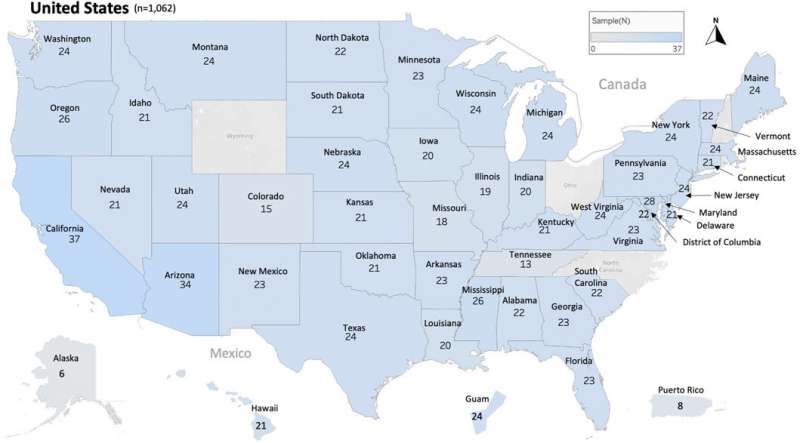This article has been reviewed according to Science X's editorial process and policies. Editors have highlighted the following attributes while ensuring the content's credibility:
fact-checked
trusted source
proofread
DNA research finds low genetic diversity among US honeybees

U.S. agriculture owes many thanks to the honeybee (Apis mellifera L.), as it plays the crucial role of pollinator within the nation's food supply. Some of the nation's food industries rely solely on the honeybee, and it's estimated that the economic value of its pollination role is worth well over $17 billion each year.
With this fact in mind, researchers from the U.S. Department of Agriculture's Agricultural Research Service recently studied the U.S. honeybee's genetic diversity to ensure that this crucial pollinator insect has sufficient diversity to overcome the growing number of stressors such as parasites, diseases, malnutrition, and climate change.
What they found is alarming: the U.S. honeybee population has low genetic diversity, and this could have a negative impact on future crop pollination and beekeeping sustainability in the country.
The research, recently highlighted in Frontiers in Genetics, was accomplished by analyzing the genetic diversity of the U.S. honeybee populations through a molecular approach, using two mitochondrial DNA (mtDNA) markers (DNA specifically from a mother). Researchers studied approximately 1,063 bees from hobbyist and commercial beekeepers in 45 U.S. states, the District of Columbia (D.C.), and two US territories (Guam and Puerto Rico).
The data showed that the nation's managed honeybee populations rely intensively on a single honeybee evolutionary lineage. In fact, 94 percent of U.S. honeybees belonged to the North Mediterranean C lineage. Data reflected that the remainder of genetic diversity belongs to the West Mediterranean M lineage (3%) and the African A lineage (3%).
"It's important that we have a realistic and accurate estimation of the honeybee's genetic diversity because this indicates the insect's ability to respond to disease, adaptation to environment, and productivity," said ARS Research Entomologist Mohamed Alburaki.
"Without this pollinator insect, we will witness a drastic decrease in the quantity and quality of our agricultural products such as almonds, apples, melons, cranberries, pumpkins, broccoli and many other fruits and vegetables that we're used to purchasing. We can't wait until a domino effect slowly takes place and affects our food supply."
The lack of genetic diversity creates a vulnerability for U.S. honeybees to survive in shifting climates that are now wetter or drier than usual. There is also concern that a honeybee's inability to fight off disease or parasitic infection could negatively impact beekeeping sustainability.
The challenge of U.S. honeybees' weakened immunity has become an economic burden to bee producers and beekeepers. In the past, U.S. beekeepers suffered less honeybee colony losses and treated against varroa mite (a ferocious honeybee parasite) once per year. In 2023, colony losses and winter mortality are at a high peak and varroa mite requires multiple treatments per year to keep it under control.
"As a honeybee researcher, what worries me the most is that 77 percent of our honeybee populations are represented by only two haplotypes, or maternal DNA, while over hundreds of haplotypes exist in the native range of this species in the Old World, or the honeybees' native land of evolution," Alburaki said.
"Many of these haplotypes have evolved over millions of years in their native lands, and have developed astonishing adaptation traits that we should consider incorporating in our U.S. honeybee stocks before it is too late."
These complex factors are driving Alburaki and his ARS research team to develop a solution that's sustainable for the entire nation. The research team is currently evaluating the paternal diversity of the previously analyzed populations to acquire a full and accurate picture of the overall genetic diversity of the U.S. honeybee populations. Researchers are also interested in the possibility of diversifying breeding stations with honeybee queens from various genetic backgrounds.
Alburaki's research also identified and named 14 novel haplotypes in the three evolutionary lineages. These haplotypes have never been reported before and can provide new insights into the U.S. honeybee's evolution since its importation to North America in the 1600s. There is hope that the researchers can use this information to locate and enhance the numbers of these rare and novel U.S. haplotypes, which could speed the process of reaching a healthier diversity within the nation's honeybee population.
More information: Mohamed Alburaki et al, Honey bee populations of the USA display restrictions in their mtDNA haplotype diversity, Frontiers in Genetics (2023). DOI: 10.3389/fgene.2022.1092121
Provided by Agricultural Research Service



















